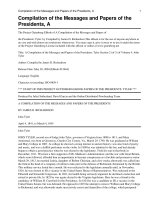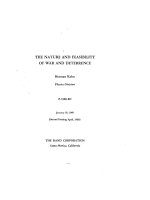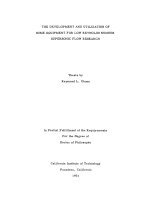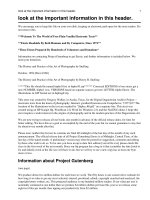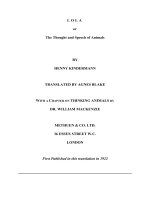01 the role and environment of managerial finance
Bạn đang xem bản rút gọn của tài liệu. Xem và tải ngay bản đầy đủ của tài liệu tại đây (1.98 MB, 58 trang )
Chapter 1
The Role and
Environment
of Managerial
Finance
Learning Goals
1. Define finance, its major areas and
opportunities available in this field, and the
legal forms of business organization.
2. Describe the managerial finance function and
its relationship to economics and accounting.
3. Identify the primary activities of the
financial manager.
4. Explain the goal of the firm, corporate
governance, the role of ethics, and
the agency issue.
Copyright © 2006 Pearson Addison-Wesley.
All rights reserved.
1-2
Learning Goals (cont.)
5. Understand financial institutions and
markets, and the role they play in
managerial finance.
6. Discuss business taxes and their
importance in financial decisions.
Copyright © 2006 Pearson Addison-Wesley.
All rights reserved.
1-3
What is Finance?
• Finance can be defined as the art and
science of managing money.
• Finance is concerned with the process,
institutions, markets, and instruments
involved in the transfer of money among
individuals, businesses, and governments.
Copyright © 2006 Pearson Addison-Wesley.
All rights reserved.
1-4
Major Areas & Opportunities in
Finance: Financial Services
• Financial Services is the area of finance
concerned with the design and delivery of
advice and financial products to
individuals, businesses, and government.
• Career opportunities include banking,
personal financial planning, investments,
real estate, and insurance.
Copyright © 2006 Pearson Addison-Wesley.
All rights reserved.
1-5
Major Areas & Opportunities in
Finance: Managerial Finance
• Managerial finance is concerned with
the duties of the financial manager in the
business firm.
• The financial manager actively manages the
financial affairs of any type of business, whether
private or public, large or small, profit-seeking or
not-for-profit.
• They are also more involved in developing
corporate strategy and improving the firm’s
competitive position.
Copyright © 2006 Pearson Addison-Wesley.
All rights reserved.
1-6
Major Areas & Opportunities in
Finance: Managerial Finance (cont.)
• Increasing globalization has complicated
the financial management function by
requiring them to be proficient in
managing cash flows in different
currencies and protecting against the risks
inherent in international transactions.
• Changing economic and regulatory
conditions also complicate the financial
management function.
Copyright © 2006 Pearson Addison-Wesley.
All rights reserved.
1-7
Legal Forms of Business Organization
Copyright © 2006 Pearson Addison-Wesley.
All rights reserved.
1-8
Corporate Organization
Copyright © 2006 Pearson Addison-Wesley.
All rights reserved.
1-9
Other Limited Liability Organizations
Copyright © 2006 Pearson Addison-Wesley.
All rights reserved.
1-10
Career Opportunities
Copyright © 2006 Pearson Addison-Wesley.
All rights reserved.
1-11
The Managerial Finance Function
• The size and importance of the managerial
finance function depends on the size of the firm.
• In small companies, the finance function may
be performed by the company president or
accounting department.
• As the business expands, finance typically
evolves into a separate department linked to the
president as was previously described in
Figure 1.1.
Copyright © 2006 Pearson Addison-Wesley.
All rights reserved.
1-12
The Managerial Finance Function:
Relationship to Economics
• The field of finance is actually an
outgrowth of economics.
• In fact, finance is sometimes referred to
as financial economics.
• Financial managers must understand the
economic framework within which they
operate in order to react or anticipate to
changes in conditions.
Copyright © 2006 Pearson Addison-Wesley.
All rights reserved.
1-13
The Managerial Finance Function:
Relationship to Economics (cont.)
• The primary economic principal used by
financial managers is marginal costbenefit analysis which says that financial
decisions should be implemented only
when added benefits exceed added costs.
Copyright © 2006 Pearson Addison-Wesley.
All rights reserved.
1-14
The Managerial Finance Function:
Relationship to Accounting
• The firm’s finance (treasurer) and
accounting (controller) functions are
closely-related and overlapping.
• In smaller firms, the financial manager
generally performs both functions.
Copyright © 2006 Pearson Addison-Wesley.
All rights reserved.
1-15
The Managerial Finance Function:
Relationship to Accounting (cont.)
• One major difference in perspective and
emphasis between finance and
accounting is that accountants generally
use the accrual method while in finance,
the focus is on cash flows.
• The significance of this difference
can be illustrated using the following
simple example.
Copyright © 2006 Pearson Addison-Wesley.
All rights reserved.
1-16
The Managerial Finance Function:
Relationship to Accounting (cont.)
• The Nassau Corporation experienced the
following activity last year:
Sales
$100,000 (1 yacht sold, 100% still uncollected)
Costs
$ 80,000 (all paid in full under supplier terms)
• Now contrast the differences in
performance under the accounting method
versus the cash method.
Copyright © 2006 Pearson Addison-Wesley.
All rights reserved.
1-17
The Managerial Finance Function:
Relationship to Accounting (cont.)
INCOME STATEMENT SUMMARY
ACCRUAL
Sales
Less: Costs
Net Profit/(Loss)
$100,000
CASH
$
0
(80,000)
(80,000)
$ 20,000
$(80,000)
Copyright © 2006 Pearson Addison-Wesley.
All rights reserved.
1-18
The Managerial Finance Function:
Relationship to Accounting (cont.)
• Finance and accounting also differ with respect
to decision-making.
• While accounting is primarily concerned with the
presentation of financial data, the financial
manager is primarily concerned with analyzing
and interpreting this information for decisionmaking purposes.
• The financial manager uses this data as a vital
tool for making decisions about the financial
aspects of the firm.
Copyright © 2006 Pearson Addison-Wesley.
All rights reserved.
1-19
Primary Activities of
the Financial Manager
Copyright © 2006 Pearson Addison-Wesley.
All rights reserved.
1-20
Goal of the Firm: Maximize Profit???
Which Investment is Preferred?
Earnings per share (EPS)
Investment
Year 1
Year 2
Year 3
Total (years 1-3)
Rotor
$
1.40
$
1.00
$
0.40
$
2.80
Valve
$
0.60
$
1.00
$
1.40
$
3.00
• Profit maximization fails to account for differences in the
level of cash flows (as opposed to profits), the timing of
these cash flows, and the risk of these cash flows.
Copyright © 2006 Pearson Addison-Wesley.
All rights reserved.
1-21
Goal of the Firm:
Maximize Shareholder Wealth!!!
• Why?
• Because maximizing shareholder wealth properly
considers cash flows, the timing of these cash flows, and
the risk of these cash flows.
• This can be illustrated using the following simple stock
valuation equation:
level & timing
of cash flows
Share Price = Future Dividends
Required Return
Copyright © 2006 Pearson Addison-Wesley.
All rights reserved.
risk of cash
flows
1-22
Goal of the Firm:
Maximize Shareholder Wealth!!! (cont.)
• The process of shareholder wealth
maximization can be described using the
following flow chart:
Copyright © 2006 Pearson Addison-Wesley.
All rights reserved.
1-23
Goal of the Firm:
What About Other Stakeholders?
• Stakeholders include all groups of individuals who have
a direct economic link to the firm including employees,
customers, suppliers, creditors, owners, and others who
have a direct economic link to the firm.
• The "Stakeholder View" prescribes that the firm make a
conscious effort to avoid actions that could be
detrimental to the wealth position of its stakeholders.
• Such a view is considered to be "socially responsible."
Copyright © 2006 Pearson Addison-Wesley.
All rights reserved.
1-24
Corporate Governance
• Corporate Governance is the system used to
direct and control a corporation.
• It defines the rights and responsibilities of key
corporate participants such as shareholders, the
board of directors, officers and managers, and
other stakeholders.
• The structure of corporate governance was
previously described in Figure 1.1.
Copyright © 2006 Pearson Addison-Wesley.
All rights reserved.
1-25


